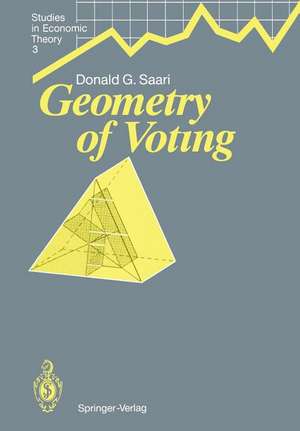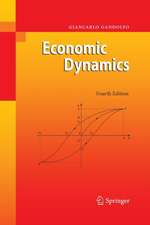Geometry of Voting: Studies in Economic Theory, cartea 3
Autor Donald G. Saarien Limba Engleză Paperback – 18 apr 2012
Din seria Studies in Economic Theory
- 18%
 Preț: 958.07 lei
Preț: 958.07 lei -
 Preț: 394.71 lei
Preț: 394.71 lei - 18%
 Preț: 952.57 lei
Preț: 952.57 lei -
 Preț: 383.93 lei
Preț: 383.93 lei - 15%
 Preț: 640.37 lei
Preț: 640.37 lei - 15%
 Preț: 645.28 lei
Preț: 645.28 lei -
 Preț: 386.39 lei
Preț: 386.39 lei -
 Preț: 394.51 lei
Preț: 394.51 lei - 18%
 Preț: 1247.26 lei
Preț: 1247.26 lei - 18%
 Preț: 1241.10 lei
Preț: 1241.10 lei - 15%
 Preț: 643.99 lei
Preț: 643.99 lei - 15%
 Preț: 644.49 lei
Preț: 644.49 lei - 15%
 Preț: 643.34 lei
Preț: 643.34 lei - 15%
 Preț: 640.88 lei
Preț: 640.88 lei - 15%
 Preț: 644.82 lei
Preț: 644.82 lei - 15%
 Preț: 645.79 lei
Preț: 645.79 lei - 18%
 Preț: 955.40 lei
Preț: 955.40 lei - 15%
 Preț: 643.00 lei
Preț: 643.00 lei - 18%
 Preț: 950.96 lei
Preț: 950.96 lei - 15%
 Preț: 636.30 lei
Preț: 636.30 lei - 18%
 Preț: 1022.48 lei
Preț: 1022.48 lei - 15%
 Preț: 641.20 lei
Preț: 641.20 lei - 15%
 Preț: 652.64 lei
Preț: 652.64 lei -
 Preț: 402.17 lei
Preț: 402.17 lei - 18%
 Preț: 954.62 lei
Preț: 954.62 lei - 15%
 Preț: 639.41 lei
Preț: 639.41 lei - 18%
 Preț: 963.15 lei
Preț: 963.15 lei
Preț: 648.05 lei
Preț vechi: 762.42 lei
-15% Nou
Puncte Express: 972
Preț estimativ în valută:
124.01€ • 132.60$ • 103.39£
124.01€ • 132.60$ • 103.39£
Carte tipărită la comandă
Livrare economică 18 aprilie-02 mai
Preluare comenzi: 021 569.72.76
Specificații
ISBN-13: 9783642486463
ISBN-10: 3642486460
Pagini: 396
Ilustrații: XVII, 372 p.
Dimensiuni: 170 x 244 x 21 mm
Greutate: 0.63 kg
Ediția:Softcover reprint of the original 1st ed. 1994
Editura: Springer Berlin, Heidelberg
Colecția Springer
Seria Studies in Economic Theory
Locul publicării:Berlin, Heidelberg, Germany
ISBN-10: 3642486460
Pagini: 396
Ilustrații: XVII, 372 p.
Dimensiuni: 170 x 244 x 21 mm
Greutate: 0.63 kg
Ediția:Softcover reprint of the original 1st ed. 1994
Editura: Springer Berlin, Heidelberg
Colecția Springer
Seria Studies in Economic Theory
Locul publicării:Berlin, Heidelberg, Germany
Public țintă
ResearchCuprins
I. From an Election Fable to Election Procedures.- 1.1 An Electoral Fable.- 1.2 The Moral of the Tale.- 1.3 From Aristotle to “Fast Eddie”.- 1.4 What Kind of Geometry.- II. Geometry for Positional and Pairwise Voting.- 2.1 Ranking Regions.- 2.2 Profiles and Election Mappings.- 2.3 Positional Voting Methods.- 2.4 What a Difference a Procedure Makes; Several Different Outcomes.- 2.5 Why Can’t an Organization Be More Like a Person?.- 2.6 Positional Versus Pairwise Voting.- III. From Symmetry to the Borda Count and Other Procedures.- 3.1 Symmetry.- 3.2 From Aggregating Pairwise Votes to the Borda Count.- 3.3 The Other Positional Voting Methods.- 3.4 Multiple Voting Schemes.- 3.5 Other Election Procedures.- IV. Many Profiles; Many New Paradoxes.- 4.1 Weak Consistency: The Sum of the Parts.- 4.2 From Involvement and Monotonicity to Manipulation.- 4.3 Proportional Representation.- 4.4 Arrow’s Theorem.- 4.5 Characterizations of Scoring, Positional and Borda.- Notes.- References.















